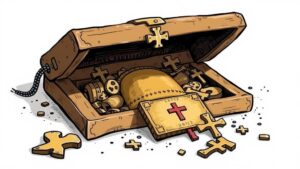Recognizing Reversed or Inverted Logic in Treasure Riddles
Recognizing Reversed or Inverted Logic in Treasure Riddles
Treasure riddles are a captivating method of presenting information that often disguises its true meanings. One intriguing aspect of these riddles is the use of reversed or inverted logic. This article delves into the nuances of recognizing such logic in treasure riddles, providing insightful examples, case studies, and applicable techniques for effective deciphering.
Understanding Reversed or Inverted Logic
Reversed or inverted logic occurs when the expected reasoning process is intentionally flipped to create a challenge. This form of logic misdirects the reader, forcing them to think outside conventional boundaries. For example, a riddle that states I am not what I appear; the less I hold, the more I am plays with the expectation of straightforward interpretation. In this case, the answer could cleverly point toward a net as it captures less than what it appears capable of holding, yet still serves a crucial function.
Characteristics of Reversed Logic in Riddles
To recognize reversed or inverted logic, its essential to identify its characteristics. Here are some key features:
- Ambiguous Phrasing: Many treasure riddles use vague or ambiguous terms that can lead to multiple interpretations.
- Contradictory Statements: The presence of statements that contradict themselves can indicate reversed logic, necessitating deeper analysis.
- Unexpected Twists: Riddles often contain twists that require the solver to approach the problem from a completely different angle.
Examples such as The more you take, the more you leave behind highlight these characteristics, with the answer being footsteps. The statement defies conventional logic, prompting solvers to rethink their approach.
Real-World Applications
Reversed logic in treasure riddles is not just a playful exercise; it has real-world implications in various domains. In education, for instance, teachers utilize riddles that incorporate reversed logic to stimulate critical thinking among students. This technique encourages learners to engage with content in a more analytical manner, enhancing problem-solving skills.
Also, in the field of psychology, understanding how individuals approach problems with reversed logic can give insight into cognitive processes. Psychologists have found that engaging with inverted logic can aid in developing creative thinking pathways. For example, puzzles and riddles have been employed in therapy to help individuals break free from rigid thought patterns.
Case Studies: Successful Recognition of Reversed Logic
Several notable figures have exhibited exceptional skill in recognizing reversed logic within treasure riddles. For example, during a treasure hunt event held in Hawaii, participants were confronted with a riddle that read, What has keys that open no locks, with space but no room, and you can enter but not go outside? The solution is “a keyboard.†Contestants who anticipated a more literal response struggled, while those thinking abstractly thrived.
In another instance, a renowned group of cryptographers encountered a riddle stating, Forward I am heavy, but backward I am not. This could leave many puzzled until the realization strikes that the answer is ton, which, when reversed, spells not. Such examples illustrate the importance of flexible thinking when dealing with inverted logic.
Techniques for Decoding Reversed Logic
Decoding treasure riddles featuring reversed logic necessitates specific techniques that can enhance ones interpretative skills:
- Look for Contextual Clues: Identify keywords in the riddle that may hold hints for alternative interpretations.
- Apply Lateral Thinking: Consider the riddle from various angles to cultivate innovative solutions.
- Encourage Collaborative Solving: Teaming with others to tackle riddles can yield diverse perspectives, enriching the problem-solving process.
By employing these techniques, individuals can better navigate the complexities associated with reversed logic, ultimately improving their success in solving treasure riddles.
Conclusion: The Art of Recognizing Inverted Logic
In summary, recognizing reversed or inverted logic in treasure riddles is a multifaceted skill that enhances critical thinking and analytical prowess. With the incorporation of strategies, such as examining phrasing, understanding the characteristics of inverted logic, and utilizing collaborative efforts, one can unlock the secrets hidden within these intriguing puzzles. Engaging with these riddles not only sharpens cognitive abilities but also serves as a delightful means of problem-solving and education.
As the importance of critical thinking continues to grow in various fields, the ability to recognize and interpret reversed logic in riddles offers a valuable methodology for individuals seeking to enhance their intellectual capabilities.



